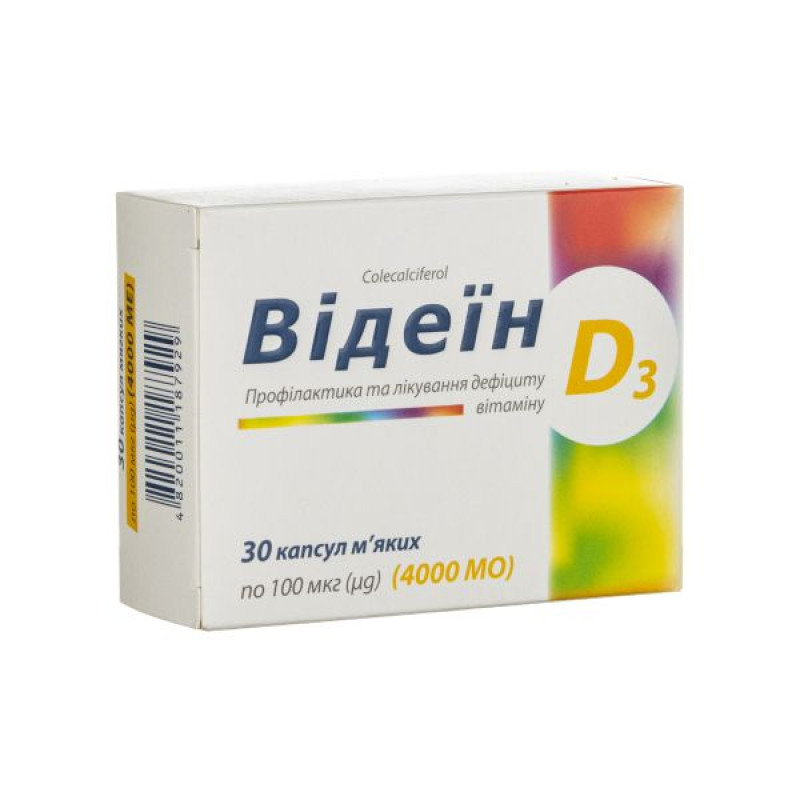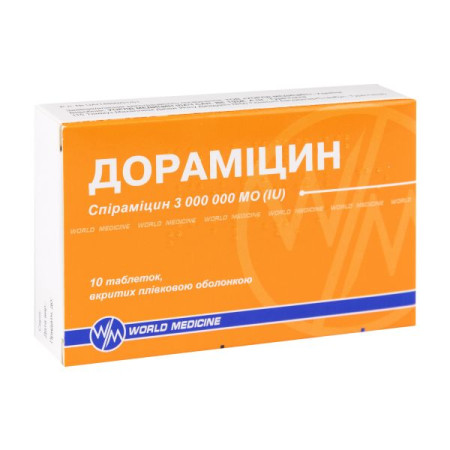Videoin capsules 4000 IU No. 30

Instructions for use Videoin capsules 4000 IU No. 30
Composition
active ingredient: cholecalciferol;
1 capsule contains 12.5 mcg of cholecalciferol (vitamin D3 – 500 IU) or 25 mcg (vitamin D3 – 1000 IU), or 100 mcg (vitamin D3 – 4000 IU);
excipients: α-tocopherol acetate; medium chain triglycerides;
capsule shell: gelatin, glycerin.
Dosage form
Soft capsules.
Main physicochemical properties:
capsules of 12.5 mcg (500 IU): soft gelatin capsules in the shape of a tube, with an elongated neck in the form of a "fish tail", with a seam, light yellow in color, filled with a colorless or slightly yellowish oily liquid;
25 mcg (1000 IU) capsules: soft gelatin capsules in the form of a tube, in the form of a "bottle", with a seam, light yellow in color, filled with a colorless or slightly yellowish oily liquid;
100 mcg (4000 IU) capsules: soft gelatin capsules, oval in shape, with a seam, light yellow in color, filled with a colorless or slightly yellowish oily liquid.
Pharmacotherapeutic group
Vitamins. Vitamin D preparations and its analogues. Cholecalciferol. ATX code A11C C05.
Pharmacological properties
Pharmacodynamics.
Vitamin D3 is an active anti-rachitic factor. The most important function of vitamin D3 is to regulate calcium and phosphate metabolism, which contributes to proper mineralization and skeletal growth.
Vitamin D3 is the natural form of vitamin D produced in animals and humans. It is 25% more active than vitamin D2. The active form is calcitriol (1,25-dihydroxyvitamin D3), the product of two consecutive hydroxylations in the liver and kidneys.
It is necessary for the functioning of the parathyroid glands, intestines, kidneys and bone system. It plays a significant role in the absorption of calcium and phosphates from the intestines, in the transport of mineral salts and in the process of bone calcification, regulates the excretion of calcium and phosphates by the kidneys. The concentration of calcium ions affects a number of important biochemical processes that maintain skeletal muscle tone, participate in the conduction of nervous excitation and affect blood clotting. Vitamin D3 is also involved in the functioning of the immune system, affects the production of lymphokines.
Lack of vitamin D3 in food, impaired absorption, calcium deficiency, and lack of exposure to sunlight during a child's rapid growth period lead to rickets, and in adults to osteomalacia, in pregnant women to the appearance of symptoms of tetany, and further to the lack of tooth enamel formation in children.
Women in menopause who suffer from osteoporosis need to increase their dose of vitamin D3 due to hormonal imbalances.
Pharmacokinetics.
Absorption: After oral administration, cholecalciferol is absorbed in the small intestine, and the presence of bile facilitates the absorption process. Therefore, impaired liver or gallbladder function and steatorrhea may interfere with the absorption of vitamin D3.
Distribution: Penetrates the placental barrier and into breast milk.
Metabolism. Metabolized in the liver and kidneys, turning into active metabolites. Calcifediol (25-hydroxyvitamin D3), a product of hepatic hydroxylation of vitamin D3, is the most circulating form of the vitamin, its half-life is 19 days.
Calcitriol (1,25-dihydroxyvitamin D3), the renal hydroxylation product of calcifediol (25-hydroxyvitamin D3), has a half-life of 3 to 5 days, which may be prolonged in renal disease, and is excreted primarily in the bile.
Calcitriol is an active metabolite that binds to a carrier protein and is transported to target organs (intestine, bones, kidneys). The half-life in the blood is several days and may be prolonged in cases of kidney disease.
Excretion: Excreted in urine and feces.
Indication
For the prevention of rickets, including in premature newborns;
for the prevention of vitamin D3 deficiency in high-risk patients who do not have absorption disorders;
for the prevention of vitamin D3 deficiency in malabsorption;
for the treatment of rickets and osteomalacia;
for the maintenance treatment of osteoporosis.
Contraindication
Hypersensitivity to the components of the drug, hypercalcemia and/or hypercalciuria, idiopathic hypercalcemia of newborns, hypervitaminosis D, sarcoidosis, renal failure, urolithiasis, nephrolithiasis, tuberculosis.
Pseudohypoparathyroidism (vitamin D requirements may be lower than during periods of normal vitamin sensitivity).
Interaction with other medicinal products and other types of interactions
Antiepileptic drugs, especially phenytoin and phenobarbital, as well as rifampicin, neomycin, cholestyramine, liquid paraffin reduce the effect of vitamin D3.
Concomitant use with thiazides increases the risk of hypercalcemia.
Concomitant use with cardiac glycosides may enhance their toxic effects (increased risk of cardiac arrhythmia).
Concomitant use of the drug with antacids containing aluminum or magnesium may provoke aluminum toxicity on bones and hypermagnesemia in patients with renal failure.
Simultaneous administration of vitamin D3 with metabolites or analogues of vitamin D is possible only as an exception and only under the condition of monitoring the level of calcium in the blood serum (the risk of toxic effects increases).
Concomitant use with drugs containing high doses of calcium or phosphorus increases the risk of hyperphosphatemia.
Vitamin D may antagonize drugs used for hypercalcemia, such as calcitonin, etidronate, and pamidronate.
Concomitant use with weight loss drugs (orlistat) and cholesterol-lowering drugs may reduce the absorption of vitamin D and other fat-soluble vitamins.
Glucocorticoid treatment may affect vitamin D metabolism.
Application features
The drug should be used with caution in immobilized patients, patients taking thiazides, cardiac glycosides, and patients with cardiovascular diseases.
When using the drug, it is necessary to take into account the additional intake of vitamin D3 (concurrent use of other drugs containing vitamin D). Combination therapy with vitamin D or calcium should be carried out only under the supervision of a physician, monitoring the level of calcium in blood serum and urine.
Individual provision of a specific need must take into account all possible sources of this vitamin.
It should be noted that a high-fat diet may increase the absorption of vitamin D3, therefore, it is recommended to follow a diet without excess fat while taking the drug.
Very high doses of the drug used for a long time, or shock doses, can cause chronic hypervitaminosis D3.
Determining a child's daily need for vitamin D and the method of its use should be established individually and verified each time during periodic examinations, especially in the first months of life.
The drug should be used with particular caution in infants born with a small anterior fontanelle.
Do not take the drug simultaneously with high doses of calcium.
During treatment with the drug, monitoring of serum and urine calcium and phosphate levels is recommended.
The drug should be used with caution in patients with impaired renal function. Long-term use of the drug requires monitoring of renal function by serum creatinine levels.
Treatment should be discontinued if symptoms of hypervitaminosis appear: fatigue, nausea, diarrhea, polyuria.
Use during pregnancy or breastfeeding
The drug should be used with caution in pregnant and breastfeeding women.
During pregnancy or breastfeeding, vitamin D intake should be monitored.
Daily doses up to 500 IU of vitamin D. The risks of using vitamin D in this dose range are unknown. Long-term overdose of vitamin D should be avoided due to the possible development of hypercalcemia.
Daily doses of more than 500 IU of vitamin D. The drug should be used during pregnancy only in case of urgent need in strictly recommended dosage. Long-term overdose of vitamin D should be avoided due to the possible development of hypercalcemia, which leads to defects in physical and mental development of the fetus, aortic stenosis and retinopathy in children.
Vitamin D and its metabolites pass into breast milk, so during breastfeeding the drug should be used only as prescribed by a doctor.
There is no data on possible overdose.
Ability to influence reaction speed when driving vehicles or other mechanisms
There are no reports that the drug affects the ability to drive or use other mechanisms. However, it is recommended to exercise special caution when driving or operating other mechanisms, given the possibility of developing adverse reactions from the nervous system.
Method of administration and doses
The medicine should be administered orally.
Adults and older children (who are able to swallow the capsule) should take the drug orally before or during meals: swallow the capsule whole with sufficient water.
For use in children from the second week of life or adults and older children who cannot swallow the capsule, squeeze the contents of the capsule into a spoon (vessel) with liquid (milk, fruit juice) or other food.
The contents of the capsule can also be added to a bottle or plate of food, but it is necessary to ensure that the food is completely consumed - otherwise it is not possible to guarantee the intake of the entire dose of the drug. The medicine should be added to the food immediately before its consumption.
How to release the contents of the capsule
Prepare a clean spoon (vessel).
Before removing the contents of the capsule into a clean spoon (vessel), wash and dry your hands thoroughly.
With two fingers of one hand, take the capsule by the tail (for "fish") or the neck (for "bottles") and press so that the liquid flows into the body of the capsule (Fig. 3).
With two fingers of your other hand, slightly stretch and tightly squeeze the neck of the capsule.
After depressurizing the capsule, squeeze out as much liquid as possible into a previously prepared clean spoon (vessel).
Prevention of rickets: The recommended dose is 1 capsule of 12.5 mcg (500 IU of vitamin D3) per day. Administer as shown in Fig. 2–6, adding the contents of the capsule to liquid or food as described above.
Prevention of rickets in premature newborns: the dose is determined by the doctor. The total recommended dose is 2 capsules of 12.5 mcg or 1 capsule of 25 mcg (1000 IU of vitamin D3) per day. Apply as shown in Fig. 2–6, adding the contents of the capsule to liquid or food as described above.
Prevention of vitamin D3 deficiency in high-risk patients without malabsorption: The recommended dose is 1 capsule of 12.5 mcg (500 IU vitamin D3) per day. The capsule can be swallowed whole or added to liquid or food as described above.
Prevention of vitamin D3 deficiency in malabsorption: the dose is determined individually by the doctor. The total recommended dose is 6–10* capsules of 12.5 mcg (3000–5000 IU of vitamin D3) or 3–5* capsules of 25 mcg (3000–5000 IU of vitamin D3). If the doctor prescribes a dose of 4000 IU of vitamin D3, use 1 capsule of 100 mcg (4000 IU of vitamin D3) per day. You can swallow the capsule whole or add the contents of the capsule to liquid or food, as described above.
Treatment of rickets and osteomalacia: the dose is determined by the doctor individually, depending on the course and severity of the disease. The total recommended dose for the treatment of vitamin D3 deficiency for infants and children is 2–10* capsules of 12.5 mcg (1000–5000 IU of vitamin D3) or 1–5* capsules of 25 mcg (1000–5000 IU of vitamin D3) per day. If the doctor prescribes a dose of 4000 IU of vitamin D3, use 1 capsule of 100 mcg (4000 IU of vitamin D3) per day.
Administer by adding the contents of the capsule to liquid or food as described above. Treatment lasts for a year.
Maintenance treatment of osteoporosis: The recommended dose is 2 capsules of 12.5 mcg (1000 IU vitamin D3) or 1 capsule of 25 mcg (1000 IU vitamin D3) per day. The capsule can be swallowed whole or added to liquid or food as described above.
Duration of use.
The duration of treatment depends on the course and severity of the disease and is determined by the doctor individually.
Treatment of rickets and osteomalacia caused by vitamin D3 deficiency lasts for one year.
Children are prescribed the drug to prevent rickets, starting from the second week of life until the end of the first year of life. During the second year of life, further use of the drug may be necessary, especially in winter.
When using doses exceeding 1000 IU of vitamin D3 per day, as well as during continuous or long-term treatment, the level of creatinine in the blood and the level of calcium in the blood serum and urine should be regularly monitored. If necessary, the dose should be adjusted depending on the concentration of calcium in the blood serum.
*If it is necessary to use high doses of cholecalciferol, it is recommended to use the drug in a different dosage form and with a higher dosage.
Children. Used in children from the second week of life.
Overdose
Vitamin D3 regulates calcium and phosphate metabolism, and overdose can cause hypercalcemia, hypercalciuria, renal calcifications, and bone damage, as well as cardiovascular changes. Hypercalcemia occurs after administration of 50,000–100,000 IU of vitamin D3 per day.
Overdose may cause the following effects: muscle weakness, loss of appetite, nausea, vomiting, constipation, polydipsia, polyuria, drowsiness, photosensitivity, pancreatitis, rhinorrhea, hyperthermia, decreased libido, conjunctivitis, hypercholesterolemia, increased transaminase activity, arterial hypertension, cardiac arrhythmia and uremia. Common symptoms are: pain in muscles and joints, headache, weight loss. Renal dysfunction develops with albuminuria, erythrocyturia and polyuria, increased potassium loss, hyposthenuria, nocturia and moderate increase in blood pressure.
In severe cases, corneal clouding is possible, less often - swelling of the optic nerve papilla, inflammation of the iris, up to the development of cataracts.
Kidney stones and calcifications in soft tissues such as blood vessels, heart, lungs, and skin may form.
Cholestatic jaundice rarely develops.
Treatment. Overdose requires treatment of hypercalcemia. The drug should be discontinued. Depending on the degree of hypercalcemia, a low-calcium or calcium-free diet, plenty of fluids, forced diuresis induced by the administration of furosemide, and the administration of glucocorticoids and calcitonin are recommended.
With normal renal function, calcium levels are significantly reduced by intravenous sodium chloride (3–6 liters over 24 hours) with the addition of furosemide; in some cases, 15 mg/kg/h of edetate sodium should also be used, with constant monitoring of calcium levels and ECG. In oligoanuria, on the contrary, hemodialysis is necessary. There is no specific antidote.
Side effects
Adverse reactions are usually not observed when used in recommended doses.
In case of individual hypersensitivity to the drug, which is rare, or as a result of using very high doses over a long period, hypervitaminosis D may occur.
On the part of the digestive tract: loss of appetite, nausea, vomiting, constipation, dry mouth, flatulence, abdominal pain, diarrhea, dyspepsia, pancreatitis.
From the nervous system: headache, drowsiness, mental disorders, depression.
From the urinary system: increased calcium levels in the blood and/or urine, urolithiasis and tissue calcification, uremia, polyuria.
Skin: hypersensitivity reactions, including urticaria, rash, itching.
Musculoskeletal system: myalgia, arthralgia, muscle weakness.
From the organs of vision: conjunctivitis, photosensitivity.
Metabolic: hypercholesterolemia, weight loss, polydipsia, increased sweating.
On the part of the hepatobiliary system: increased activity of aminotransferases.
On the part of the psyche: decreased libido.
There have also been reports of rhinorrhea, hyperthermia, and dry mouth.
Expiration date
2 years.
Storage conditions
Store in the original packaging at a temperature not exceeding 25 °C.
Keep out of reach of children.
Packaging
10 capsules in a blister; 3 blisters in a pack.
10 capsules in a blister; 6 blisters in a pack.
Vacation category
Without a prescription.
Producer
JSC "KYIV VITAMIN FACTORY".
Location of the manufacturer and address of its place of business.
04073, Ukraine, Kyiv, Kopylivska St., 38.
Website: www.vitamin.com.ua
There are no reviews for this product.
There are no reviews for this product, be the first to leave your review.
No questions about this product, be the first and ask your question.










